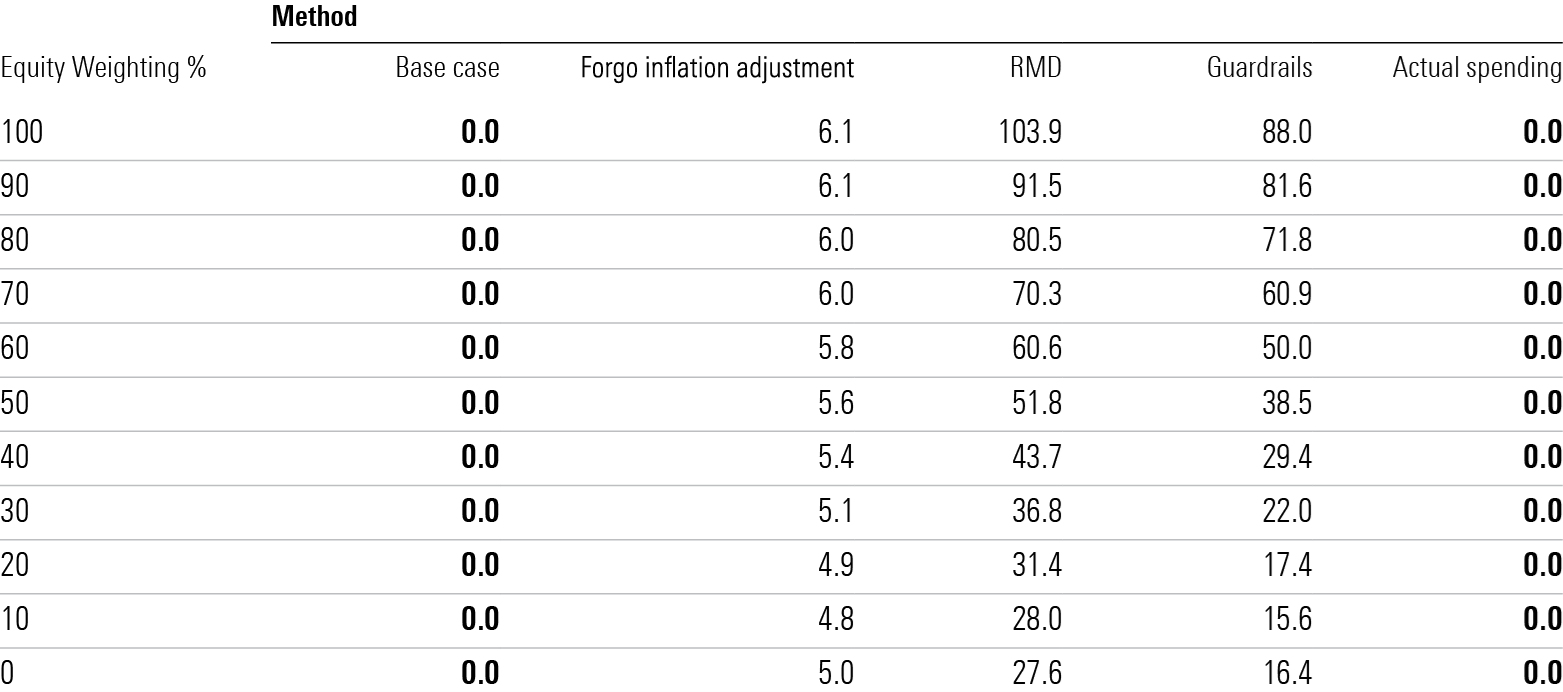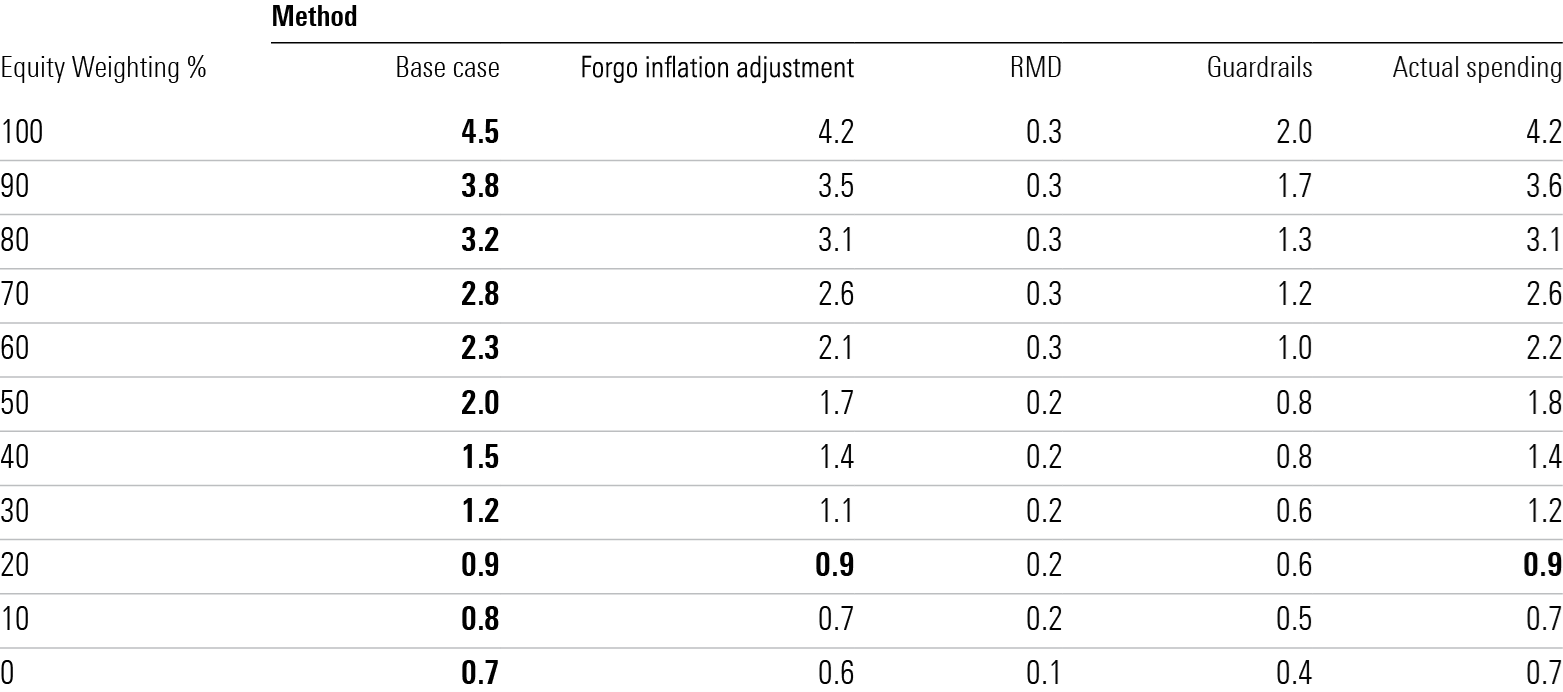The Best Flexible Strategies for Retirement Income
Is a more dynamic approach to retirement spending right for you?

In our recent annual study on safe withdrawal rates, my colleagues Christine Benz, John Rekenthaler, and I found that retirees who want to maintain a consistent spending amount adjusted for inflation will need to keep their starting withdrawals at 4.0% or lower if they want to lock in a 90% probability of success over a 30-year time horizon. This system of “fixed real” withdrawals offers the benefit of simplicity and most closely approximates the consistent paychecks that most people grow accustomed to during their working years.
But some retirees might find a more flexible approach to retirement withdrawals more appealing. Strategies that involve changing withdrawal amounts from year to year—taking lower withdrawals in weak market environments and perhaps higher paydays in very strong ones—typically allow for higher withdrawal rates. Flexible strategies are effective because they help to prevent retirees from overspending in periods of market weakness, while giving them a raise in stronger market environments.
To help identify how flexible strategies balance lifetime income with considerations of quality of life and the volatility of cash flows, we also tested some of the most widely used flexible strategies, benchmarking them against the baseline system.
In this article, I’ll look at the pros and cons of the four variable withdrawal strategies we tested, as well as the type of retiree each one might be most appropriate for.
Method 1: Forgoing inflation adjustments following annual portfolio loss.
This method, advocated by (among others) T. Rowe Price, begins with the base case of fixed real withdrawals throughout a 30-year time horizon. However, to preserve assets following down markets, the retiree skips the inflation adjustment for the year following a year in which the portfolio has declined in value. For example, a person following this strategy wouldn’t increase portfolio withdrawals after the 2022′s bear market, despite the large jump in inflation during the year. This might seem like a modest step, but the cuts in real spending, while small, are cumulative. That is, the effects of such cuts ripple into the future, as these changes permanently reduce the retiree’s spending pattern. This method is also conservative because it doesn’t boost the real withdrawal amount even after a large increase in portfolio value.
Method 2: Required minimum distributions.
This is the same framework that underpins required minimum distributions from tax-deferred accounts like IRAs. In its simplest form, the RMD method is portfolio value divided by life expectancy. For life expectancy, we used the IRS’ Single Life Expectancy Table and assumed a 30-year retirement time horizon, from ages 65 to 94. (We employed the updated RMD calculations that went into effect in 2022.)
This method is inherently “safe” and designed to ensure that a retiree will never deplete the portfolio because the withdrawal amount is always a percentage of the remaining balance. (In contrast to the other methods in the paper, the percentages withdrawn are based on the current portfolio value, not the original balance.) However, an RMD system incorporates two key variables for retirement-spending plans: remaining life expectancy and remaining portfolio value. While changes in life expectancy are gradual, the fact that the remaining portfolio value can change significantly from year to year adds substantial volatility to cash flows.
Method 3: Guardrails.
Originally developed by financial planner Jonathan Guyton and computer scientist William Klinger, the guardrails method sets an initial withdrawal percentage, then adjusts subsequent withdrawals annually based on portfolio performance and the previous withdrawal percentage. The guardrails attempt to deliver sufficient—but not overly high—raises in upward-trending markets while adjusting downward after market losses. In upward-trending markets, in which the portfolio performs well and the new withdrawal percentage (adjusted for inflation) falls below 20% of its initial level, the withdrawal increases by the inflation adjustment plus another 10%.
To use a simple example, let’s say the starting withdrawal percentage is 4% of $1 million, or $40,000. If the portfolio increases to $1.4 million at the beginning of Year 2, the retiree could automatically take $40,000 plus an inflation adjustment—$40,968, based on a 2.42% inflation rate. Dividing that amount by the current balance—$1.4 million—tests for the percentage. The amount of $40,968 is just 2.9% of $1.4 million. As that 2.9% figure is 28% less than the starting percentage of 4%, the retiree qualifies for an upward adjustment of 10%. The new withdrawal amount becomes $45,065—the scheduled amount of $40,968 plus the additional 10% of $4,097.
The guardrails apply during down markets, too. Specifically, the retiree cuts spending by 10% if the new withdrawal rate (adjusted for inflation) is 20% above its initial level. For example, let’s say the retiree withdrawing 4% ($40,000) of the $1 million portfolio in Year 1 immediately strikes an investment iceberg, losing 30% of the portfolio value in Year 1. The portfolio drops to just $672,000 at the beginning of Year 2. The Year 2 withdrawal would be $40,968 on a pretest basis. But because $40,968 from $672,000 is a 6.1% withdrawal rate—far above the initial 4%—the retiree would need to reduce the scheduled $40,968 amount by 10%, to $36,871.
The Guyton-Klinger method scraps the cutback rules (following portfolio declines) during the final 15 years of retirement, in acknowledgment of the fact that weak returns are especially dangerous early in retirement but less so later on. Guyton-Klinger also includes some portfolio-management rules related to the spending of various assets—for example, if the equity allocation exceeds its target allocation because of strong performance, the excess equity exposure is sold and added to cash. However, for this exercise, we focused exclusively on changes to the withdrawal rate rather than including the portfolio management rules.
Method 4 (new for 2023): Spending declines in line with historical data.
We also tested a strategy that incorporates the average decline in spending that occurs over the retirement lifecycle. In past studies, we incorporated this spending pattern by assuming that the hypothetical retirees did not adjust their annual withdrawals by the full amount of inflation but instead by 1 percentage point less than the annual inflation rate.
In this year’s study, we further refined this method by incorporating more specific patterns observable in retiree spending at various life stages. Research from the Employee Benefits Research Institute [1] demonstrates that inflation-adjusted household spending has historically fallen by 19% from age 65 to 75, 34% from age 65 to 85, and 52% from age 65 to 95. We adjusted the annual spending numbers to match up with these longer-term declines. To reflect this, Method 4 assumes that real retirement spending declines by 1.9 percentage points per year between age 65 and 75; 1.5 percentage points per year between 75 and 85; and 1.8 percentage points per year between 85 and 95.
Testing the Four Strategies
For each strategy, we used stochastic (Monte Carlo) modeling to test how successful withdrawal systems—meaning that a given system ensured that a retiree did not run out of money over a 30-year time horizon—fared on a few key metrics. As with the base case, we defined success as not running out of money in 90% of the random trials. We employed a 40% equity/60% fixed-income portfolio as the baseline case but also looked at other asset allocations.
The metrics were as follows:
Starting Safe Withdrawal Rate: What starting withdrawal rate would have been supported for 30-year periods with a 90% probability of success (with “success” defined as a positive account balance at the end of the 30-year horizon)?
Lifetime Portfolio Withdrawal Rate (Internal Rate of Return): What was the average lifetime withdrawal amount, factoring in any upward or downward adjustments that the flexible strategy entailed, that would have been supported for 30-year periods with a 90% probability of success? We calculate this as the average value of the annual withdrawals (discounted by the 2.42% inflation rate) for the 1,000 simulated trials.
Year 30 Cash Flow Standard Deviation: To what extent did withdrawals vary on a year-to-year basis? To approximate this variance, we examine the standard deviation of the withdrawals that take place in Year 30 across the 1,000 simulated trials. The higher the standard deviation, the greater potential variation in spending across the retirement horizon.
Median Ending Value at Year 30: What is the median portfolio balance that remains at the end of the 30-year period? To arrive at this figure, we find the median balance for the 1,000 trials remaining at the end of the 30-year periods. This metric is critical for those who wish to maintain (or even grow) their assets to leave something behind for heirs or charity.
Comparing the Methods
Each method entails its own set of trade-offs. Below, we compare each method based on the four analyzed metrics: starting safe withdrawal rates, lifetime portfolio withdrawal rates, Year 30 cash flow standard deviation, and median ending value at Year 30. The exhibit below depicts how each method fared on each metric, assuming 40% stock/60% bond portfolios, a 30-year spending horizon, and a 90% success rate. The spending method that delivers the best outcome is noted in bold. Note: The table below also shows how these metrics stack up for a TIPS ladder strategy, which John Rekenthaler wrote about here.
Spending Methods Summary, 40% Equity/60% Bond Portfolio, 30 Years, and 90% Success Rates

Starting Safe Withdrawal Rate
Each flexible spending method supports a higher initial safe withdrawal rate than the fixed real withdrawal method, as shown above. But the guardrails method supports the highest starting safe withdrawal rates across most asset allocations. This reflects the nature of the approach, which can support higher initial withdrawals by making potentially significant year-to-year adjustments to dollar withdrawals by throttling spending down at inopportune times.
For the other methods, starting safe withdrawal rates are generally highest with equity allocations ranging from 20%-40% and tended to be lowest in less-diversified allocations like 100% stocks. However, because our expectations for fixed-income returns (primarily cash) have ticked up while assumptions for equity returns have edged down, less equity-heavy allocations come out looking better than they did in last year’s study.
30-Year Starting Safe Withdrawal Rate % by Withdrawal Method and Asset Allocation, 90% Success Rate

Lifetime Portfolio Withdrawal Rate
Most flexible spending approaches boast a higher lifetime withdrawal rate than the fixed real withdrawal method, across the asset-allocation spectrum. The RMD and guardrails methods support the highest lifetime withdrawal rates, while forgoing an inflation adjustment in the year following a portfolio loss also offers slightly higher levels of lifetime income than the baseline fixed real withdrawal approach.
Notably, equity-heavy allocations under the guardrails and RMD methods support higher lifetime withdrawal rates than bond-heavy allocations. That is because the portfolios with higher equity allocations provided larger “raises” in annual withdrawals following good years, thereby enlarging lifetime withdrawal amounts. As always, though, there are trade-offs, as the increases in portfolio spending reduce the portfolios’ ending values.
30-Year Lifetime Withdrawal Rate % by Withdrawal Method and Asset Allocation, 90% Success Rate

Year 30 Cash Flow Standard Deviation
With this measure, the trade-offs demanded by the RMD and guardrails methods become apparent. Both approaches have far greater variability in their annual withdrawal amounts. Such unpredictability is a natural byproduct of their rules, which can dictate higher or lower spending under certain circumstances. Thus, retirees who are attracted to these methods’ high withdrawal rates must also reckon with the substantial uncertainty they can impose. By contrast, the forgo-inflation and actual spending methods entail relatively little year-to-year spending change, making them more useful to retirees who prize stability and predictability.
Year 30 Cash Flow Standard Deviation % by Withdrawal Method and Asset Allocation, 90% Success Rate

Median Ending Value at Year 30
The base case of taking fixed real withdrawals creates some of the highest median balances at Year 30. In other words, retirees using such a strategy may well underspend during their lifetimes. That attribute depresses potential spending but may appeal to bequest-minded retirees. Among the flexible withdrawal methods, the actual spending method and the forgo inflation method produced the highest Year 30 values, on average. At the other extreme, the RMD method resulted in the lowest ending values.
This result is because it spends down most of the retirement capital by design. The guardrails approach splits the difference between a more aggressive, freer-spending method like RMD and thriftier methods that curtail, but never increase, spending.
Median Ending Value at Year 30 ($ Mil) by Withdrawal Method and Asset Allocation, 90% Success Rate

Final Thoughts
While the 4% rule based on historical market returns is the most well-known method for retirement withdrawals, there are many other approaches retirees can adopt. The guardrails system—flexible withdrawals with parameters, or guardrails, that prevent withdrawals from being either too high or too low—does the best job of enlarging payouts in a safe and livable way. But retirees may want to consider other approaches depending on whether they want to prioritize maximizing the starting withdrawal rate, lifetime withdrawals, cash flow stability, or leaving behind a legacy for loved ones or charity.
[1] Banerjee, S. “Expenditure Patterns of Older Americans, 2001−2009,” EBRI Issue Brief, No. 368, February 2012.
The author or authors do not own shares in any securities mentioned in this article. Find out about Morningstar’s editorial policies.

/s3.amazonaws.com/arc-authors/morningstar/360a595b-3706-41f3-862d-b9d4d069160e.jpg)
/cloudfront-us-east-1.images.arcpublishing.com/morningstar/YBH7V3XCWJ3PA4VSXNZPYW2BTY.png)
/d10o6nnig0wrdw.cloudfront.net/04-24-2024/t_a8760b3ac02f4548998bbc4870d54393_name_file_960x540_1600_v4_.jpg)
/cloudfront-us-east-1.images.arcpublishing.com/morningstar/O26WRUD25T72CBHU6ONJ676P24.png)
:quality(80)/s3.amazonaws.com/arc-authors/morningstar/360a595b-3706-41f3-862d-b9d4d069160e.jpg)